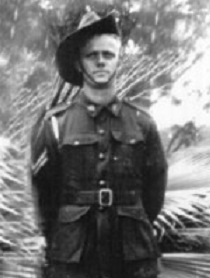IPKENDANZ, Eric William
| Service Number: | N164752 |
|---|---|
| Enlisted: | 22 January 1942 |
| Last Rank: | Lance Sergeant |
| Last Unit: | 6th (NSW) Battalion Volunteer Defence Corps (VDC) |
| Born: | Gunnedah, New South Wales, Australia, 28 May 1922 |
| Home Town: | Gunnedah, Gunnedah, New South Wales |
| Schooling: | Tambar Springs Primary School and Maitland High School, New South Wales, Australia |
| Occupation: | Farmer |
| Died: | Redcliffe, Western Australia, 4 September 2017, aged 95 years, cause of death not yet discovered |
| Cemetery: | Not yet discovered |
| Memorials: |
World War 2 Service
| 22 Jan 1942: | Enlisted Australian Military Forces (WW2) , Lance Sergeant, N164752, 6th (NSW) Battalion Volunteer Defence Corps (VDC) | |
|---|---|---|
| 30 Sep 1945: | Discharged Australian Military Forces (WW2) , Lance Sergeant, N164752, 6th (NSW) Battalion Volunteer Defence Corps (VDC) |
Eric IPKENDANZ VDC
Eric IPKENDANZ enlisted in the Volunteer Defence Corps (VDC) at Gunnedah, New South Wales on 22 January 1942 and was attached to the 6th Battalion VDC (Tamworth District). At full strength there were 33 Battalions of VDC troops in New South Wales. On 19 April 1944 Eric was promoted to corporal and soon after to Lance Sergeant. On 7 September 1944 Eric was transferred to the 29th Battalion VDC on Reserve and was discharged on 30 September 1945.
Recollections by Eric in VDC service (1999):
“Ours was the 6th Battalion with headquarters in Tamworth, Company Headquarters were at the showground in Gunnedah, and I was appointed Corporal in charge of the unit at Tambar (Tambar Springs, NSW). With only one .303 rifle issued because of a severe shortage at that time, some thirty wooden copies of this rifle by size and shape were made at “Killawarra” (Eric’s father’s rural property at Tambar Springs) from pine boards to enable the unit to immediately begin basic drill training.
Initially our weapons were personal rifles and shotguns, with half sticks of gelignite with detonator and short fuse for hand grenades. We were much better off for machine guns, being issued with a variety of First World War models brought to light from arsenals around the country. These included the Hotchkiss, as used by the Light Horse, the British air-cooled Lewis with rotary magazine, the heavy water-cooled Vickers with belt feed and the captured German Spandau converted to .303 with a belt feed. A fine weapon.
As it became available, we were issued with standard A.M.F. equipment. That was MK4 .303 rifles, Owen sub machine guns, Bren machine guns, 3-inch mortars, Bren track carriers and army trucks. Training in guerilla war tactics, and subsequent exercises in actual battle practice were conducted on various properties in the Gunnedah, Curlewis and Tamworth districts with concentrated week-long exercises. These were held at the then closed down Keepit Dam construction site which had accommodation huts, and was our base training camp and mobilisation point for the Battalion in the event of a call to action. Much of our training was done with live ammunition and our instructors played the role of the enemy with live overhead machine gun fire and ground explosions.
Later I was promoted to Lance Sergeant and allocated an additional and separate function as an instructor on the Bren light machine gun. I was issued with a Bren and ammunition which I kept at home, and with it travelled most weekends to other district local VDC training sessions to give instruction on this very efficient weapon. When not training or on exercises, we all worked in our normal jobs, and kept all personal military issue equipment with us to facilitate speedy mobilisation.
In addition to the operational roles indicated above, some VDC units had been allocated specific areas of coastline to be defended on very short notice in the event of an imminent Japanese landing. We were to be used as an expendable first line of defence troops until the major landing location had been determined, and the regular army deployed for subsequent action. Our allocated area was between Hexham and Newcastle which fortunately we were never called up on to defend.”
Submitted 26 March 2025 by Peter Ipkendanz











